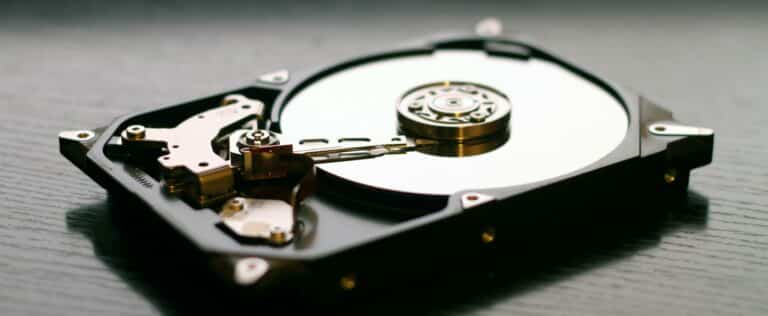Hard Drives For Sale Online
A computer’s operating system and other programmes are stored on the hard drive. Upon system boot or application launch, all critical system files and programmes are loaded into random access memory (RAM) from the hard drive. A hard drive is fundamental for the functioning of a computer. Hard drives are still essential in modern computers and laptops for storing data, creating system clones, and backing up and restoring. At Shop Scanner we aim to enhance our hard disk buying experience to give you the best product at the best price.

Types of Hard Drives for Sale Online
Parallel ATA (PATA)
PATA, commonly known as ATA or IDE, is a standard interface for IBM PC-compatible systems.Compaq and Western Digital introduced PATA hard drives in 1986. It can transport data at 133 MB/S and hold 80GB. A drive interface connects gadgets and hard discs to the computer. Each PATA hard disc transfers data in 16-bit pockets in parallel using 40 or 80 ribbon connections. It greatly influenced modern society’s digital evolution. Its features no longer fit contemporary needs, hence it is becoming outdated.
Serial-ATA
Serial ATA hard drives remain the most popular. Their motherboard and OS support is nearly universal. They’re affordable and contain terabytes of storage. SATA drives are commonly 3.5-inch for desktops and 2.7-inch for laptops.
Small Computer System Interface
SCSI was invented in the 1970s and uses a 50-pin flat ribbon connector to connect hard drives and other devices to computers. It connects and transfers data between computers, scanners, CD drives, and printers.
Solid State Hard Drive (SSD)
Modern solid-state hard drives use memory chips instead of rotating magnetic discs. It has no fragile bits or moving discs. SSD saves data on a semiconductor chip utilising flash memory. Since ssd is safe, people constantly shift os there.
Internal and External Drives
Desktops, laptops, servers, and consoles have internal hard drives that store operating systems, software, system files, and other data. These hard drives connect directly to the motherboard. Manufacturers don’t make portable internal HDDs.
External hard drives are portable. External storage is usually enclosed and connected to a computer via USB, Thunderbolt, or eSATA. External HDDs are used for backups and media libraries.

Understanding Hard Drive Specifications and How to Choose From the Hard Drives for Sale
Browse our range of hard drives for sale before making your final choice.
Form Factors
Hard drive form factor comprises its size and characteristics. Traditional internal and external hard drives have two sizes. Desktops use 3.5-inch drives. Laptops use 2.5-inch drives. Thin computers employ a rarer, slimmer 2.5-inch disc. Form factor encompasses the hard drive’s physical profile and host interface connector position. Without the right form factor, users will not be able to install a new hard drive.
Compatibility
Form factor doesn’t limit compatibility. All hard drives have host interfaces. Hard drive interfaces control how they communicate with the host desktop or laptop. Interfaces transport data at varying speeds.
The most popular internal and external hard drive host interfaces are:
- SATA is the most common desktop hard drive interface. Second-generation SATA II transfers data at 3 Gbps. SATA III is a 6 Gbps third-generation interface. These transfer speeds satisfy most residential users.
- USB is universally compatible with internal drives but more common for external hard drives. USB connections allow external drivers to connect to USB ports, including USB Type-C. USB interfaces are multigenerational. Standard generations include USB 2.0, 3.0, and 3.1. USB type determines transmission speed. USB 2.0 transfers speeds up to 480 Mbps. USB 3.0 can transfer data at 5 Gbps, while USB 3.1 can do 10 Gbps.
- Thunderbolt: Mac-formatted external hard drives and peripherals use this high-speed connectivity. Thunderbolt 3 uses USB-C ports but transfers quicker.
- SATA’s external counterpart is eSATA. This interface connects external hard discs quickly and reliably.
- Ethernet: Network-attached storage (NAS) devices use Ethernet ports to connect to a network and share files.
- SAS: SAS interfaces are less prevalent than SATA but thrive in enterprise-class storage applications that require excellent performance, durability, and scalability.
Capacity
Hard drive capacity is measured in gigabytes (GB) and terabytes (TB). As of last year, 256 GB, 512 GB, 1 TB, 2 TB, and 4 TB have proven to be popular capacities. Commercial hard drives store up to 20 TB. Desktop hard drives hold more than laptops.
Manufacturers and operating systems measure storage differently, therefore a hard drive’s claimed and useable capacity differ. Thus, a 1 TB drive will typically hold 931 GB.
Speed of Data Transfer
Transfer rates, measured in megabytes (MB) and gigabytes per second, indicate how fast hard drives can send and receive data from other computer components, including the motherboard. Data transfer speeds show users a hard drive’s sequential and random data exchange capabilities.
Mean Time Between Failures (MTBF)
MTBF is the most popular hard drive reliability statistic. The MTBF assesses the device’s typical lifespan in hours until a repairable or terminal failure. The MTBF simulations are approximations. Real-world situations effect hard drive longevity.
Mean Time to Failure (MTTF)
Hard drive reliability is sometimes measured by the MTTF that predicts the device’s average lifespan in hours until terminal failure. Hard drive maintenance and use might affect its lifespan.
Revolutions Per Minute
High-RPM hard drives have faster access and sequential speeds. Most HDD platters spin at 5400 or 7200 RPM. Users without specific needs, such as editing high-resolution photographs and videos or gaming, can choose 5400 RPM. Hard drives of 7200 RPM or above are best for fast access and sequential speeds. These hard drives produce greater heat and mechanical stress than lower RPM devices, making them less dependable in most cases. Taking such trade-off into account is vital. 7200 RPM and higher drives use more power and create more noise than 5400 RPM ones.
Speed of Sequential and Random Read/Write
Hard drives’ sequential and random read/write rates indicate data access and storage speed. The sequential speed measures how long it takes to read or write a block of data. For huge data like backups or streaming videos, sequential read/write rates are increasingly important.
Random speed measures how long the drive takes to read or write random disc data. Random read/write speeds hinder multitasking like launching numerous apps or managing smaller files. Faster sequential and random speeds improve usability.
Appropriate for Gaming
It’s normal to buy a hard drive to supplement your system’s internal storage because games have grown bigger. Multiple manufacturers make console- or gaming-specific hard drives to operate well under certain settings. For console storage expansion drives, look for that branding.
For now, playstation 5 (PS5) games only run on internal storage. It is possible to copy PS5 games to external storage, but you’ll have to reload them before you can play them.
Security Features
While security features are not related to performance or dependability, they are nonetheless important when selecting a hard drive. Hardware encryption improves security without affecting speed. An encrypted drive can secure personal data from unauthorised access.
Manufacturers provide password protection and encryption in some hard drives. This function requires a password or PIN to access files. Some models have secure erasure for long-term data protection. Secure erasure overwrites internal data, including unallocated space, to sanitise storage devices and protect sensitive data.
Why Buy a Hard Drive From Us?
Shop Scanner is the best place for hard drive aficionados to find the best storage options. Immerse yourself in our vast inventory of hard drives for sale, which includes popular brands and models for any budget. Buying a hard drive has never been easier with our streamlined interface, safe payment options, and lightning-fast delivery. You can rest easy knowing that you will discover the ideal storage solution for your needs thanks to the thorough product descriptions and extensive customer assistance. You will get the most sought-after hard drives on the internet, regardless of whether you need fast performance, large capacity, or strong reliability.
Frequently Asked Questions
HDD and NAND-based storage media companies saw revenue and sales dip this year, but AI demand is expected to turn this around in 2024. HDD shipments fell each quarter in 2023, while NAND prices plummeted.
General capacity and read/write performance are the most crucial HDD buying factors. As long as you don’t sacrifice performance or durability, a larger drive is preferable for capacity.
SSDs rule laptops and gaming PCs, but datacentres use spinning disc drives. This trend is expected to last until 2028, when SSD sales will outpace hard drives.
Hard drives contain more moving parts and are less reliable than solid-state drives. This is why hard discs last 3–5 years.
If you like our range of Hard Drives, you might also be interested in our selection of Desktop Computers

